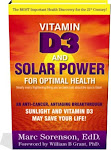Note: The comments on this blog are for information only. Do not make any changes in sunlight exposure, tanning-bed exposure or nutritional habits without first consulting a medical professional.
There has been a concerted effort by the “Powers of Darkness” to ensure that children avoid that most natural of childhood activities—playing outdoors in the sun. Yet, it is known that girls who have the greatest exposure to sunlight during the ages of 10-19 have a 35% decreased risk of cancer as adults when compared to those who had the least exposure. Sunlight is essential for optimal human health and it is criminal to deprive children and adults of mankind’s most healthful friend. It is likely that much of sunlight’s cancer-preventive properties are mediated by vitamin D.
Adult habits of sun exposure also make a profound difference in the risk of breast cancer. Dr Esther John and colleagues conducted research on the sun-exposure habits of women and correlated those habits to the risk of developing breast cancer. Those women who had the greatest exposure to sunlight were 65% less likely to develop breast cancer. Isn’t it interesting that the most potent anti-cancer agent may be something that the cancer societies have defined as a carcinogen (something that causes cancer)? That anti-cancer agent is sunshine, which produces vitamin D. Research shows that women with a combination of a genetically susceptible tendency to breast cancer and a low blood level of vitamin D (less than 20 ng/ml) had nearly seven times the breast cancer rate as those without a family history of susceptibility genetics and a blood level above 20 ng/ml. Another investigation pointed out that those women with the highest serum levels of vitamin D had a 69% reduced risk when compared to those with the lowest levels. There was a striking dose-response relationship between higher vitamin D and lower breast-cancer risk.
Vitamin D also makes a terrific difference in the progression and spread of breast cancer after it is diagnosed. Blood levels of vitamin D at the time of diagnosis of breast cancer accurately predict a woman’s survival. The cancer is much more aggressive in those whose serum vitamin D levels are low; they are 94% more likely to have the cancer metastasize (spread to other tissue) and 73% more likely to die within ten years of diagnosis.
So what is the bottom line? Another analysis estimated that maintaining a vitamin D blood level of 55ng/ml would prevent the breast-cancer deaths of 85,000 US women yearly and that the deaths prevented worldwide would be 350,000; still another showed that moderate sunlight exposure combined with 2,000 IU of vitamin supplementation would be sufficient to produce the levels necessary to achieve such a reduction in breast-cancer risk and death. We must no longer ignore the beneficial health influences of sunlight and vitamin D on breast cancer or any of the other myriad disorders such as heart disease and osteoporosis that correlate so closely to vitamin D deficiency.
(References for the statements in this blog are found in my book.)
Subscribe to:
Post Comments (Atom)


1 comment:
Great Post! It is great to hear that there are things people can do in order to reduce their chances of developing certain illnesses. Here is website that I came across that also supports the view that Calcium & Vitamin D intake may lower Breast Cancer risk. Read more http://www.oncologistoncology.com/category_story_1190.html
Post a Comment